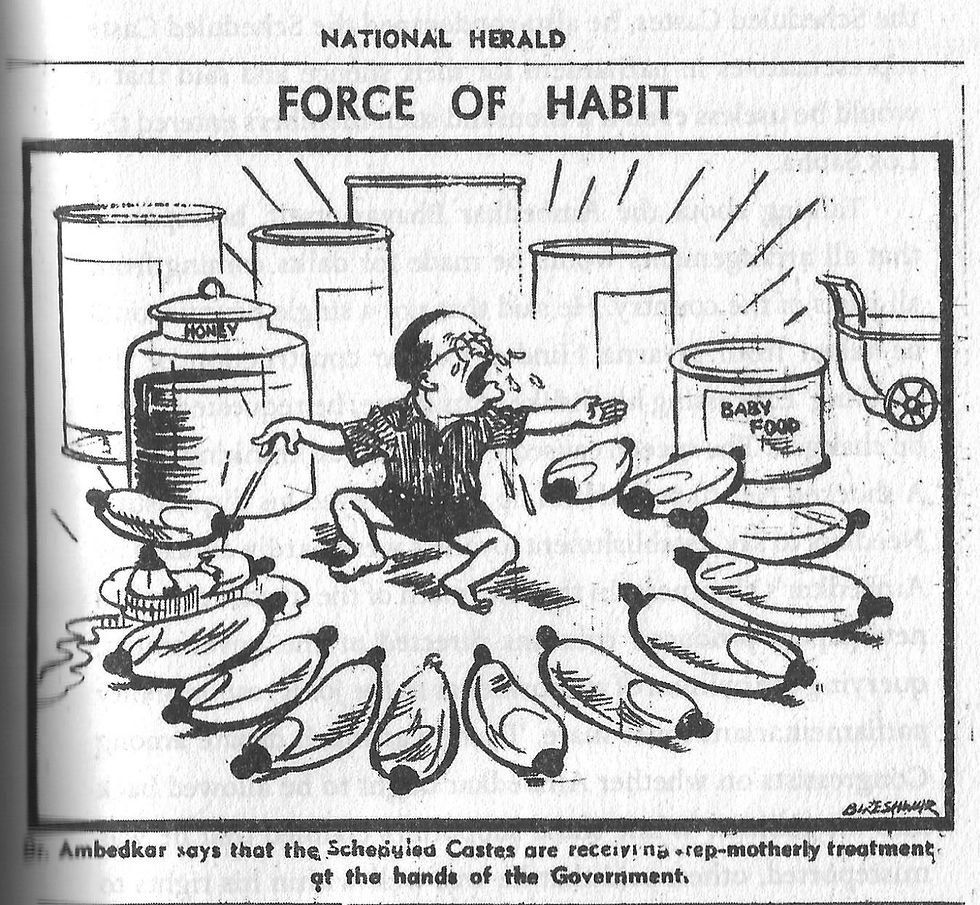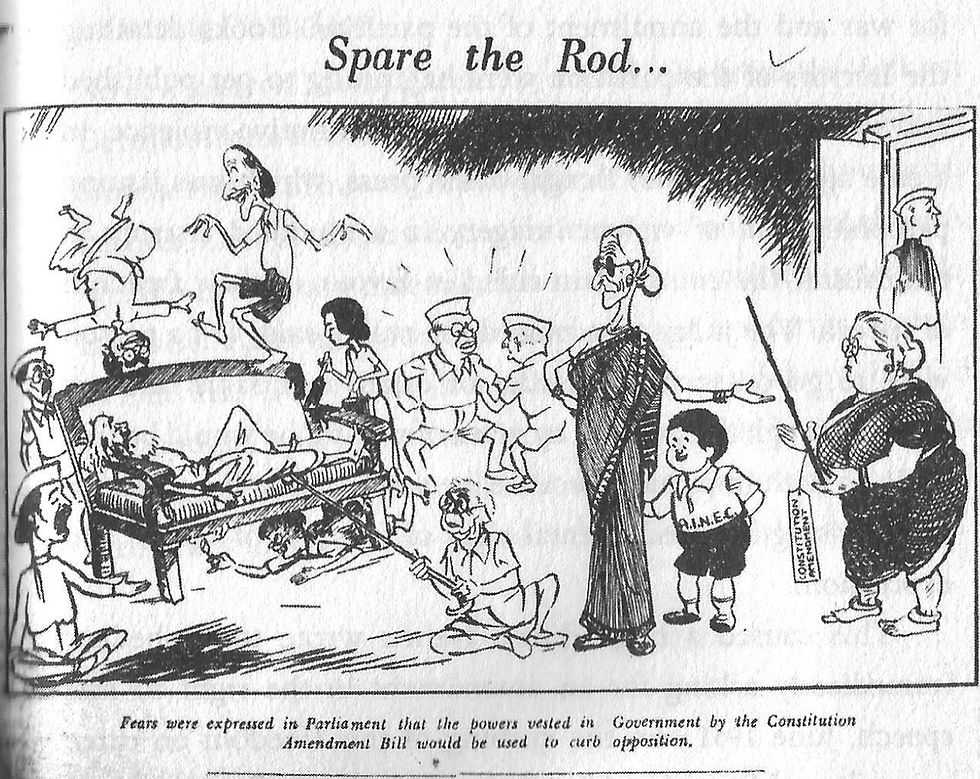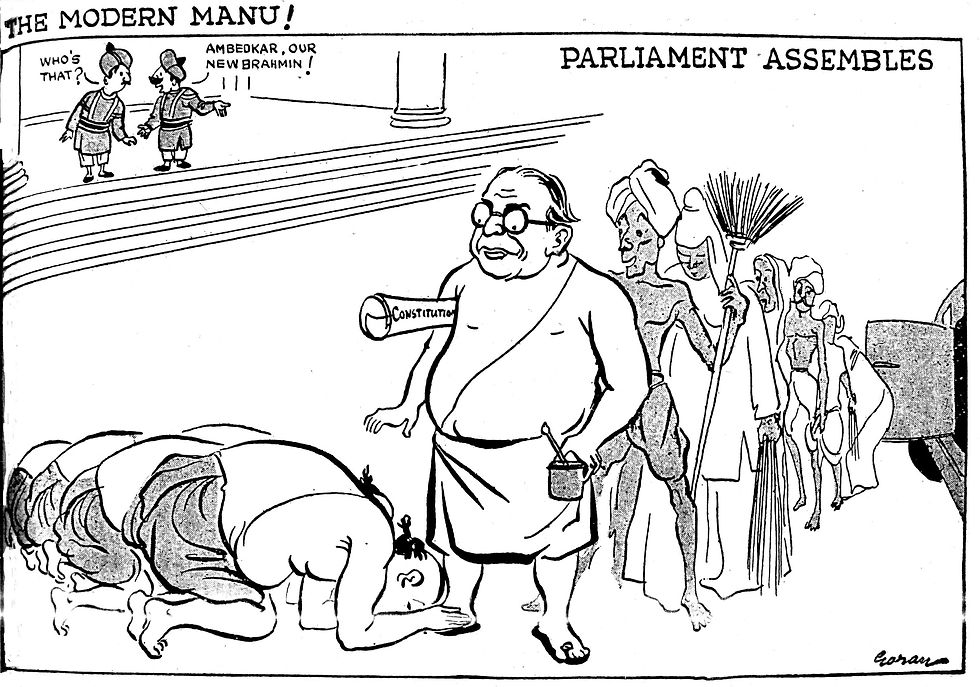
“If Ambedkar’s appearance in cartoons signals his growing role as a shaper of history, the caricatures of him all too frequently replace one idiom of prejudice and subjugation with another, casteist slurs sliding into the easy sexism of the cartoonist.”
— Unnamati Syama Sundar
Memes are often considered the new cool, the MVPs if you will, for offering witty commentary on social and political events via social media. However, let's not overlook the newspapers that have been using cartoons to do the same thing for decades. Memes have simply taken the baton and run with it, increasing the reach of satirical humor. The fact is, satire in a visual form tends to capture more attention and offers a unique perspective that is often lost in the sea of textual information.

Published by Navayana “No Laughing Matter: The Ambedkar Cartoons, 1932-1956” by Unnamati Syama Sundar dives into the world of traditional cartoons (printed in English newspapers), and explores a specific collection of them (122 in total) covering about 25 years of Babasaheb Ambedkar's life through an anti-caste lens. From depictions of him riding a donkey, munching on books, dragging buffaloes, and even sporting a saree in his early years, to being portrayed as a janeau-clad powerhouse, single-handedly dominating the constituent assembly in his later years, Ambedkar's life was chronicled in a range of cartoons that captured the changing perceptions of his social and political significance.

The book tells the story of a whole era through the text that accompanies each cartoon. But these aren't just random notes; they are a nuanced interpretation of historical events, replete with sharp criticism. The author has done his homework, going through tons of archives, books, and speeches to put this thing together, and to provide timely insights into the subject matter. The 'Scratching the Surface' section, meanwhile, humorously critiques the cartoons from a modern perspective, highlighting the limitations of their attempts at humor. The Foreword of the book, written by Suraj Yengde, suggests that it could be considered a political biography of Ambedkar from a unique perspective, with the possible subtitle, "As Seen from the Other Side of the Fence."
However, do not mistake this book for your typical sentimental tribute. It's actually a two-sided account that showcases the very cartoons that may seem biased against its own subject. With blatant casteist undertones, these cartoons more often than not depicted Ambedkar in a derogatory manner, placing him at the bottom rung of the socio-political ladder and using humor that is anything but “laughing matter”.
“We celebrate a man who drew inspiration from the French Revolution”, writes the author, “and yet we appear to rail against the political cartooning tradition that is its very legacy.”
Consider this:

In this cartoon about the First Constitutional Amendment Bill, Rajagopalachari is depicted as a female school headmistress, while Ambedkar is shown barefoot and dressed as a Maharashtrian maid, suggesting a subordinate position, alluding to proposed restrictions on the freedom of the press.
Or consider this:

Ambedkar aimed to “annihilate” the caste system, which involved eliminating the hierarchy and the different levels of authority within it. However, in the above cartoon, both Ambedkar and the Dalits who followed in his footsteps and opposed Brahmanism have been labeled as ‘new Brahmins,’ “without any sense of history or irony”, writes Syam about the cartoon. P.S. Do not miss the janeau.
For his readers, comments Yogesh Maitreya, “Syam has carefully decoded each cartoon with historical precision and an anti-caste filter. This enables him to thoroughly explain not only the politics of cartoons, but the politics of aesthetics in India and its incentives as well.”
Overall, the book prompts readers to ponder the potential and constraints of humor as a means of social commentary. Syama Sundar cautions us that there has been little progress regarding the portrayal of the caste issue or Dalit public figures in cartoons, particularly in spaces controlled by savarnas, in modern-day India. “We surely do not live in a more enlightened time.”
Brilliantly written!